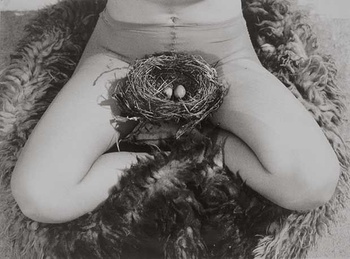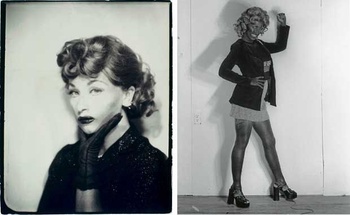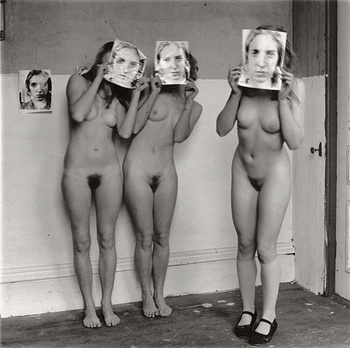Nest, 1979 © Estate of Birgit Jürgenssen / Courtesy of Galerie Hubert Winter, Vienna / SAMMLUNG VERBUND, Vienna
The fifth edition of the Summer of Photography, which is being staged by no fewer than 30 partners, focuses on women and on gender issues. Among the many exhibitions to be seen in Brussels, “WOMAN. The Feminist Avant-Garde of the 1970s”, the event’s key exhibition at Bozar, turns the spotlight on 29 female artists – including Cindy Sherman, Francesca Woodman, and Birgit Jürgenssen – who, on both sides of the Atlantic, completely changed the ways in which women are depicted.
In 1971, the US art historian Linda Nochlin caused a stir with an article entitled “Why Have There Been No Great Women Artists?” In the course of the Seventies, buoyed by the May ’68 wave and the revival of feminist demands, a whole generation of female artists took to photography, video, and performance – territory over which men had not yet established hegemonic domination – in order to present their own images of womanhood
Summer of Photography: women in the vanguard


© Cindy Sherman/Courtesy of Metro Pictures, New York/Sammlung Verbund, Vienna
The “WOMAN. The Feminist Avant-Garde of the 1970s” exhibition brings together more than 400 disconcerting, amusing, crude, poetic, and ironic works that, almost 40 years later, have lost none of their power and relevance. “Some of these works are still provocative today,” explains Gabriele Schor, the exhibition’s curator, who is the director of the Sammlung Verbund, a Vienna-based collection from which all the works on show have come. “Before Brussels, we presented the exhibition in Rome, at the Galleria Nazionale d’Arte Moderna, but there were some things we couldn’t show. One of the feminist slogans of the time was ‘The personal is political’. From that perspective, and often using their own bodies, these female artists tackled, for the first time, subjects such as pregnancy, maternity, sexuality, the canons of beauty, rape, etc.”
What is the main difference between the image of women as presented by men and the image of women as presented by women themselves?
Gabriele Schor: Here, it is the women themselves who decide to show their bodies. You can feel that they have a different sexuality, a different way of expressing themselves. There is also the fact that they are not too concerned about beauty – or that they have a different idea of beauty. Beauty is not the most important thing for them.
A large part of the exhibition is devoted to Cindy Sherman, who is undoubtedly the best-known of all these artists – but with works from early in her career.
Schor: The works in question are not very well-known; they date from when she was a student at the State University College in Buffalo, before the famous series of “Untitled Film Stills”. In her self-portraits, she already adopted several identities, using make-up and dressing up. One of the artists who influenced her was Hannah Wilke, by whom we present a series in which she adopts poses characteristic of Mary Magdalene and Jesus in Christian iconography, gradually shifting from one to the other.
The “WOMAN. The Feminist Avant-Garde of the 1970s” exhibition brings together more than 400 disconcerting, amusing, crude, poetic, and ironic works that, almost 40 years later, have lost none of their power and relevance. “Some of these works are still provocative today,” explains Gabriele Schor, the exhibition’s curator, who is the director of the Sammlung Verbund, a Vienna-based collection from which all the works on show have come. “Before Brussels, we presented the exhibition in Rome, at the Galleria Nazionale d’Arte Moderna, but there were some things we couldn’t show. One of the feminist slogans of the time was ‘The personal is political’. From that perspective, and often using their own bodies, these female artists tackled, for the first time, subjects such as pregnancy, maternity, sexuality, the canons of beauty, rape, etc.”
What is the main difference between the image of women as presented by men and the image of women as presented by women themselves?
Gabriele Schor: Here, it is the women themselves who decide to show their bodies. You can feel that they have a different sexuality, a different way of expressing themselves. There is also the fact that they are not too concerned about beauty – or that they have a different idea of beauty. Beauty is not the most important thing for them.
A large part of the exhibition is devoted to Cindy Sherman, who is undoubtedly the best-known of all these artists – but with works from early in her career.
Schor: The works in question are not very well-known; they date from when she was a student at the State University College in Buffalo, before the famous series of “Untitled Film Stills”. In her self-portraits, she already adopted several identities, using make-up and dressing up. One of the artists who influenced her was Hannah Wilke, by whom we present a series in which she adopts poses characteristic of Mary Magdalene and Jesus in Christian iconography, gradually shifting from one to the other.

Francesca Woodman © George & Betty Woodman, New York/Sammlung Verbund, Vienna
You are also showing quite a few works by another American, Francesca Woodman.
Schor: She was an artist who produced photographs over nine years, from the age of 13 to the age of 22, when she committed suicide. Lots of people say that you can foresee her suicide from her photographs. But I think the most important thing is to look at her work, not taking the end as your starting point, but starting at the beginning and seeing how she staged her photographs in abandoned factories, using objects and her own body. In her work, space is very important.
Did this female avant-garde movement develop mainly in the United States?
Schor: The movement began in New York and Los Angeles, but exhibitions of feminist art took place in almost all the big cities of Europe. In Austria, there was Birgit Jürgenssen, who speaks of metamorphoses and of the female body with irony and a certain kind of surrealism, as well as Renate Bertlmann, Valie Export, and others. There was Ketty La Rocca in Italy, Annegret Soltau in Germany... For the most part, those artists didn’t know each other, but they show a very similar approach. Most of them are not very well-known internationally, but they did work that was very important at that time and some of them are still working today. In terms of the history of art, it’s good that they are beginning to be discovered.
SUMMER OF PHOTOGRAPHY
WOMAN: The Feminist Avant-Garde of the 1970s 18/6 > 31/8, Bozar
You are also showing quite a few works by another American, Francesca Woodman.
Schor: She was an artist who produced photographs over nine years, from the age of 13 to the age of 22, when she committed suicide. Lots of people say that you can foresee her suicide from her photographs. But I think the most important thing is to look at her work, not taking the end as your starting point, but starting at the beginning and seeing how she staged her photographs in abandoned factories, using objects and her own body. In her work, space is very important.
Did this female avant-garde movement develop mainly in the United States?
Schor: The movement began in New York and Los Angeles, but exhibitions of feminist art took place in almost all the big cities of Europe. In Austria, there was Birgit Jürgenssen, who speaks of metamorphoses and of the female body with irony and a certain kind of surrealism, as well as Renate Bertlmann, Valie Export, and others. There was Ketty La Rocca in Italy, Annegret Soltau in Germany... For the most part, those artists didn’t know each other, but they show a very similar approach. Most of them are not very well-known internationally, but they did work that was very important at that time and some of them are still working today. In terms of the history of art, it’s good that they are beginning to be discovered.
SUMMER OF PHOTOGRAPHY
WOMAN: The Feminist Avant-Garde of the 1970s 18/6 > 31/8, Bozar
Read more about: Expo
Fijn dat je wil reageren. Wie reageert, gaat akkoord met onze huisregels. Hoe reageren via Disqus? Een woordje uitleg.